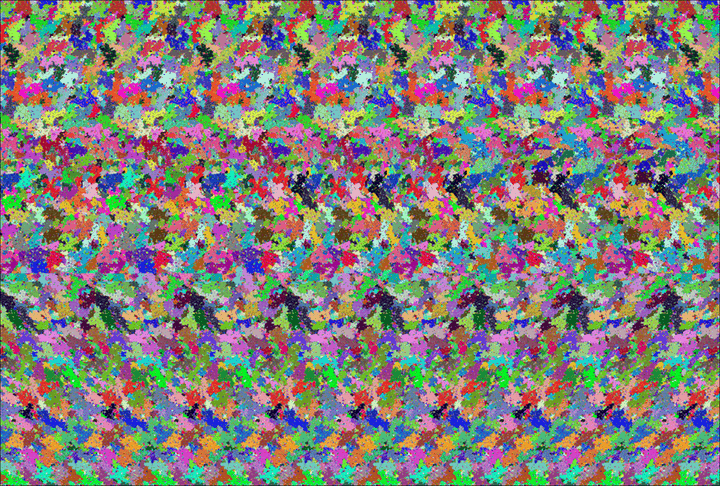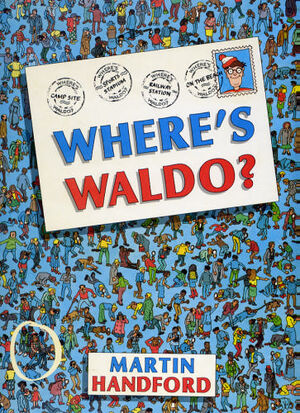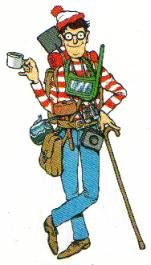
It's a well-known fact that all children enjoy staring at a two dimensional image for so long that their eyes begin to glaze over and water uncontrollably. Their heads may ache, their eyes may lose focus, and their patience may wear paper thin, but nothing will impede them from their ultimate visual goal. Though usually it is near impossible to force a child to stay still, set one in front of a Magic Eye book or poster and prepare to be amazed: not by the Magic we were promised, but rather by the level of maddening concentration associated with capturing it.
There was nothing worse than being the one kid who couldn't see the hidden image. If you were ocularly challenged in a manner that hindered your useless ability to view a supposedly three dimensional image amongst a repetitive sea of two-dimensional images, you were relegated to endless ridicule and social alienation. God help you if you suffered from the curse of poor binocular disparity, as you were likely headed for a sad and lonely existence devoid of exciting jump-from-the-page imagery. A seemingly pointless skill of blank staring suddenly set apart the Haves from the Have Nots.
In bookstores and classrooms across the nation, the same conversation was taking place between increasingly frustrated pairs of children:
Kid #1: Look at the picture.
Kid #2: Okay, I'm looking. (long pause) So, what's supposed to happen here?
Kid #1: You'll see something.
Kid #2: I'll see what?
Kid #1: Just look at it!
Kid #2: I am looking.
Kid #1: No, look past it.
Kid #2: Oh, I think I kind of...
Kid #1: Do you see it now?
Kid #2: Um, yeah, I think so.
Kid #1: So what is it?
Kid #2: A...whale?
Kid #1: Ugh, it's the Statue of Liberty. Man, you suck at these things.
(Kid #2 walks off with pounding eye strain-based headache and wounded pride)
And...scene.
Nobody really seemed to know how these things worked, and no one really seemed to care. The real test of 90s childhood street credibility was an uncanny capacity to descramble austereogramatic images. I know, it makes perfect sense. How else are we supposed to prioritize our social structure? Brains? Looks? Give me a break. It was Magic Eye or nothing.

The burning shame of not being one of the Chosen Ones was both crippling and inescapable. Living with the constant fear that our mothers' old adages of our crossed eyes forever sticking that way was not enough to deter us from staring intently until our brains were set to burst. We were determined that this would be the time that we would finally see what everyone was raving about. Those who were skilled in the ways of the Magic Eye were constantly coaching us, insisting that we were doing it wrong. Despite our protests of poor depth perception or an inability to visually construct convergent images, the Seers were neverendingly giving us all sorts of well-meaning contradictory viewing tips:
"Cross your eyes a little!"
"Eyeballs further apart!"
"Look to the left of it!"
"The other left!"
"Try to focus on one spot!"
"Don't focus your eyes on anything at all!"
"Try to look past it!"
That last one was always my favorite. Oh, you want me to look past it? I was foolishly looking at it. Alrighty, no problem. I knew this x-ray vision would eventually come in handy. I'll just gaze straight through the paper to the next page and I'll be set.
Unfortunately, this brand sarcasm was lost on our persistent Magic Eye instructors. After all, who cares about attitude when you've got magical pictures? Hopeful that their Magic Eye proteges may have finally blossomed into fully evolved viewers capable of perceiving 3D imagery, the Seers would eagerly ask, "Can you see it now?" Horribly embarrassed by our ineptitude, we would have to grudgingly admit time and time again that we still lacked the basic ogling skills necessary to deconstruct a series of seemingly meaningless colored dots. Try as we might, we would never be content to simply accept it as a moderately attractive example of pointilistic art. We knew it was so much more, and we wanted in.
Thankfully, our dear uploading friends over at YouTube have put together an instructional video of sorts. Don't let the soothing music and whimsical font fool you. This thing is serious. I followed the instructions to a T, but somewhere along the way my plan to see a glorious hidden three-dimensional image took a turn for the worst. It brought me right back to 1995, with all my Seeing friends telling me, "You're thinking about it too much. Just stare at it. Don't think about it at all." Right. Because telling me not to think too much about it leads me to think about it prominently and intently. Why don't you give it a try and see what you see:
Isn't that nice? They offer that little consolatory image at the end to offset the continued wrenching humiliation of those of us unable to see the 3D picture. If you can see it, congratulations. Your ocular capacity clearly exceeds mine, and I respect your visual superiority. However, if you failed to see the image, you are not alone; in fact, many of our celebrated television personalities faced the same issue, sometimes as a minor offshoot plotline!
On the original Ellen show, Ellen Degeneres desperately tried to hide her secret inability to Magic Eye. An episode of Seinfeld left George and others so transfixed by the Magic Eye task at hand that they were unable to complete the rudimentary functions of their everyday lives. And of course, we can't forget out beloved Friend Ross Gellar, who was chastised by the whole group for his incompetence at drawing out the 3D Statue of Liberty in one of the most popular Magic Eye pictures. US magazine has been right all along, they really are just like us! And they say there are no relatable characters in sitcoms.
Thus if you're feeling down about your lack of Magical Eyes, rest your weary sockets. You're among good company. For those of you who can see the mythical images, well, continue to bask in your transcendent ability. A skill you thought had been laid to rest years ago has briefly returned just long enough for you to reassert your superiority over the Blind. By tomorrow your so-called skill will reclaim its rightful place in obsolescence and your gloating rights will dissolve like the two dimensional dots from the three dimensional Statue of Liberty.
Enjoy it while it lasts, you lucky bastards.










